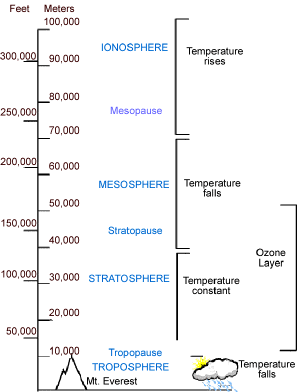BACKGROUND:
The atmosphere is the gaseous envelope
which covers a planet or large satellite. Most planets in our solar system
have some type of an atmosphere. The Earth's atmosphere is a mixture of gases.
Heavier gases tend to settle to the lower layers and lighter gases like
hydrogen and helium go toward the top of the atmosphere.
The atmosphere can be divided into the
following layers: troposphere (0-8 to17.6 km depending on location on
Earth, temperature decreases with height, major gas is nitrogen, water vapor
is component); stratosphere (17.6-48 km, temperature constant, weather
constant); ozone layer (32 km thick, ozone is formed by a photochemical
process. Solar ultraviolet radiation causes oxygen O2 to become O3
or ozone); mesosphere (44-88 km, temperature falls); ionosphere
(88-200 km; temperature rises, short wave radiation causes a large number of
charged ions and free electrons, good conductor of electricity).
Clouds, in combination with wind and
pressure differences, are useful indicators of weather changes. The amount of
water vapor decreases the higher you go into the troposphere, the highest
clouds are relatively thin. However, the lower levels of the atmosphere can
form clouds that are both thicker and denser.
Precipitation is common among altostratus,
nimbostratus, and cumulonimbus clouds. altocumulus, stratocumulus, stratus, or
cumulus under special conditions can cause rain. Cirrus, cirrostratus, and
cirrocumulus may produce snow. Stratus clouds may produce drizzle, whereas
cumulus clouds usually produce showers. Cumulonimbus clouds are usually
accompanied by showers or rain, snow or hail, often with thunderstorms or even
tornadoes. Altostratus or nimbostratus usually produce a steady rain.
PROCEDURE:
- Show students the many divisions of the
atmosphere. Use the diagram below. Ask the students where most of the weather
occurs? The troposphere, because the interaction of the water and land
throughout the water cycle makes this layer a dynamic moving system

Click to enlarge
- In this lab the students will classify
the clouds by using the enclosed pictures. Students may want to go outside
first and classify the clouds that they see. Students should cut the photos
out, label what they think each cloud is, and then put the clouds in some kind
of collage that reflects the height of the clouds.
- The following definitions can help you
explain the characteristics of clouds. Stratus are layered, or blanket-like;
cumulus are flat bottomed, globular, or heaped masses; cirrus are curl or
streaks; nimbus means dark rain clouds; alto means high clouds.
FAMILY A. High clouds (mean lower level, 20,000 feet)
- cirrus
- Cirrocumulus
- Cirrostratus
FAMILY B. Middle Clouds (mean upper level, 20,000 feet;
mean lower level, 6,500 feet)
- Altocumulus
- Altostratus
FAMILY C. Low Clouds (Mean upper level, 6500 feet; mean
lower level, close to surface)
- Stratocumulus
- Stratus
- Nimbostratus
FAMILY D. Clouds with Vertical Development (mean upper
level, that of cirrus; mean lower level, 1,600 feet)
- Cumulus
- Cumulonimbus
- If you have internet access, visit the
following site that can have students look at more cloud types. You can add
clouds to this lab easily.
http://www.australiansevereweather.com/
Australian Severe Weather has a complete photography gallery of
every cloud imaginable.
- ANSWERS:
- Cumulus
- Stratus, stratocumulus
- Stratocumulus
- Stratus cumulus
- Cumulonimbus
- Cumulonimbus
- Cumulus
|
- Cirrus, cirrostratus
- Altocumulus
- Altostratus
- Stratocumulus
- Stratus
- Nimbostratus
|
|